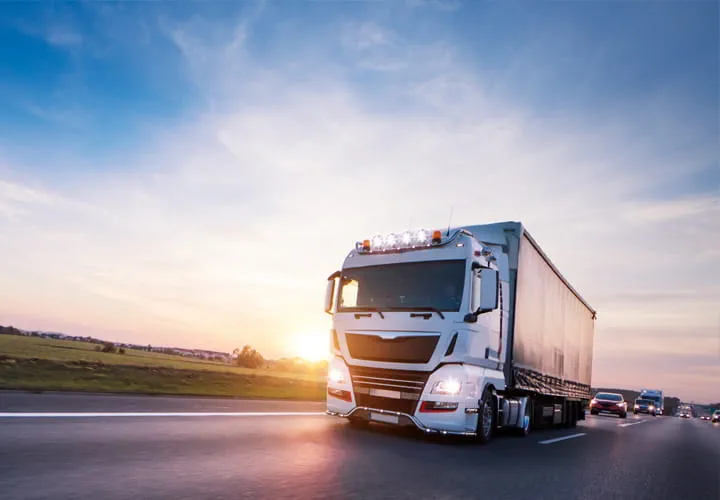The road to the future

Sweden has set an ambitious target to reduce greenhouse gas emissions from domestic road transport by 70 percent from 2010 to 2030. This requires a reduction of one million tons of emissions per year over the next 10 years, and electrification of roads is key in reaching this goal. Four different solutions for road electrification are being tested in Sweden, and Trelleborg Seals & Profiles is contributing with a tailor-made sealing solution.
To meet the environmental targets set in the United Nations’ Agenda 2030, the transport sector needs to reduce emissions by replacing fossil fuels with low-carbon options. Possible ways forward include electrification of the road transport sector through electric vehicles with static charging, electric road systems and using electricity to produce fuel.
Sweden is a pioneer when it comes to electric road systems. The country has set a target of reducing greenhouse gas emissions from domestic road transport by 70 percent from 2010 to 2030. By 2020, there is only 20 percent of the reduction achieved, which means an annual reduction of one million tons during the remaining 10 years. So, there is a need to step up to meet the target.
The Swedish Transport Administration (Trafikverket) is assigned to identify roads in Sweden where electrification is possible, and four different solutions have been tested at demonstration sites. The goal set by the Swedish government is to find 3,000 kilometers of roads with heavy traffic that can be adapted for electrification.
An overhead power line at the first site, a two-kilometer-long stretch on the E16 highway close to Sandviken in central Sweden, saw trucks equipped with pantographs used as test vehicles. The four-year test period ended in 2020.
The second demonstration is the eRoad Arlanda project, a two-kilometer part of the public road between Arlanda airport outside Stockholm and the Rosersberg logistics center. Vehicles use a movable arm to pick up the electricity from an electric rail immersed in the road. The test period for this installation is 2018 to 2021.
A third way to feed electricity to vehicles is a conductive connection between the electric road and the vehicle through a pickup installed under the vehicle. The pickup connects to the road by sliding along electrified rails laid on top of the road, thus transmitting power and charging the vehicle’s batteries, providing an efficient transfer of power from the rails to the vehicle. This solution is being tested in the Evolution Road project in Lund in southern Sweden, using a city bus as the primary test vehicle. The test period is between 2020 and 2022.
Finally, Smartroad Gotland is a demonstration of a 1.6-kilometer-long electric road situated between the airport and town center of Visby on the island of Gotland, in the Baltic Sea. This is an inductive system where receivers pick up electricity under the vehicle’s chassis from a copper cord immersed in the road. The test period here is also between 2020 and 2022.
“It takes a multitude of solutions to make it possible for all kinds of traffic to switch to a fossil-free system,” says Jan Pettersson, head of Trafikverket’s program for electrification of heavy transport. “Electric roads are a solution with a very big potential that also utilizes existing road infrastructure. It may also need to use other technologies than those in these demonstrations.”
In its latest report on the development of electric roads, Trafikverket concludes that the concept will be most suitable for long-distance transport on the roads with the most traffic, and that the priority main roads main roads in a first step are between the cities of Stockholm, Gothenburg and Malmö.
The incentive to invest in vehicles for electric roads will depend on the share of goods transported on these roads, and Trafikverket calculates that the volume should be 40 percent or more to make this solution profitable.
Still, Pettersson says electric road transport has a potential in Sweden.
“Based on the demonstrations and other considerations, we have identified at least 2,400 kilometers of roads that are suitable for electrification,” he says.

The eMobility market is very fast paced with new technologies and players constantly emerging. It is one in which original equipment manufacturers and system suppliers face distinctive challenges and ever-changing requirements. This makes the industry unique, in that customers do not yet have clearly defined standards or established solutions. The innovation rate in the industry is extremely high, with strong pressure to bring the right products to market quickly.
To keep the industry’s momentum going, customers need component suppliers who are reliable and competent partners who can react quickly to meet their needs, from design, product development and prototyping through to serial production.
At Trelleborg, the customer is always the biggest focus. By combining innovation, technology, and an efficient R&D organization, leads to a reduction in the time needed to develop products and manufacture the first functional prototypes.
In the Swedish road electrification projects, Trelleborg has contributed with tailor-made sealing solutions.
“We have developed a customized rubber sealing for the electric rails,” says Anna Scheuren, Area Sales Manager/Business Development Manager at Trelleborg Seals & Profiles EMEA. “The seals have to provide a reliable sealing function against water ingress into the rail system and also maintain the electric conduction to the pickup connection area.
“It is a very demanding application not only due to the wear caused by the pickup device under the test vehicles, but also from the usual non-electric traffic on the road. The sealing has to withstand very harsh weather conditions, with road temperatures ranging from minus 40 degrees Celsius during the coldest part of the winter to more than 60 degrees Celsius on the hottest summer days.”
In addition to electric road projects, Trelleborg Seals & Profiles is constantly developing leading-edge solutions for all parts of the eMobility industry.
“We’re proud to be a key player in this booming and important market and will continue to push for the next innovation that will allow electric vehicles to go farther and faster more effectively,” Scheuren says.


